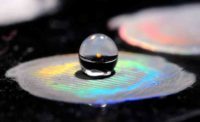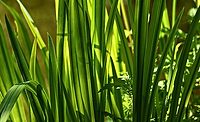Researchers Develop Coating to Make Soap Pour Cleanly from Plastic Bottles

COLUMBUS, OH — Researchers at The Ohio State University have found a way to create the perfect texture inside plastic bottles to let soap products flow freely. They describe the patent-pending technology in a paper that appeared in the journal Philosophical Transactions of the Royal Society on June 27.
The technique involves lining a plastic bottle with microscopic y-shaped structures that cradle the droplets of soap aloft above tiny air pockets, so that the soap never actually touches the inside of the bottle. The “y” structures are built up using much smaller nanoparticles made of silica, or quartz, that when treated further, won’t stick to soap.
Coatings already exist to help food, but not soap, pour out of their containers, said Bharat Bhushan, Ohio Eminent Scholar. “Compared to soaps, getting ketchup out of a bottle is trivial. Our coating repels liquids in general, but getting it to repel soap was the hard part.”
The key, he explained, is surface tension—the tendency of the molecules of a substance to stick to each other. Ketchup and other sauces are made mostly of water, and water molecules tend to stick to each other more than they stick to plastic.
But surfactants are just the opposite. They have a very low surface tension and stick to plastic easily, explained Philip Brown, a postdoctoral fellow. “It was an extra challenge for us to make a surface that could repel surfactant,” he said.
Their goal, which was suggested by a commercial shampoo manufacturer, was to create a shampoo bottle lining that was cheap, effective and environmentally friendly.
Bhushan and Brown came up with a method to spray-coat a small amount of solvent and ultra-fine silica nanoparticles onto the inside of bottles. Manufacturers already use solvents to change the texture of molded plastics, because they cause the surface of the plastic to soften a little. By mixing the silica and solvent, the researchers were able to soften the surface of the polypropylene just enough that when the plastic re-hardened, the silica would be embedded in the surface.
The structures are only a few micrometers-millionths of a meter high and covered in even smaller branchlike projections. They look like shaggy heart-shaped pillows, but they’re hard as glass.
They don’t cover the inside of the bottle completely, either, but instead are planted a few micrometers apart. The main branches of the “y” overhang the plastic surface at an angle less than 90 degrees—steep enough that water, oils and even surfactant can’t physically sustain a droplet shape that would fall in between the branches and touch the plastic.
“You end up with air pockets underneath, and that’s what gives you liquid repellency,” Brown said. Instead of spreading out on the surface, the soap droplets form beads and roll right off.
Researchers have known for some time that a support structure with the right angle of overhang would solve this problem, and some have tried to carve the shapes into plastic manually using photolithography—the same technique that shapes computer chips.
“That’s expensive and time consuming,” Brown said. “Plus, they end up with fragile little overhangs that snap off. We embedded a hard material directly into the polymer surface, so we know it’s durable.”
The invention could actually aid recycling. Before plastic bottles can be recycled, they have to be rinsed completely clean, and Bhushan suspects that he’s not the only person who doesn’t bother.
With further development, the university hopes to license the coating technique to manufacturers, not just for shampoo bottles, but for other plastic products that have to stay clean, such as biomedical devices or catheters. They have already applied the same technique to polycarbonate, a plastic used in car headlights and smartphone cases, among other applications.
Looking for a reprint of this article?
From high-res PDFs to custom plaques, order your copy today!








